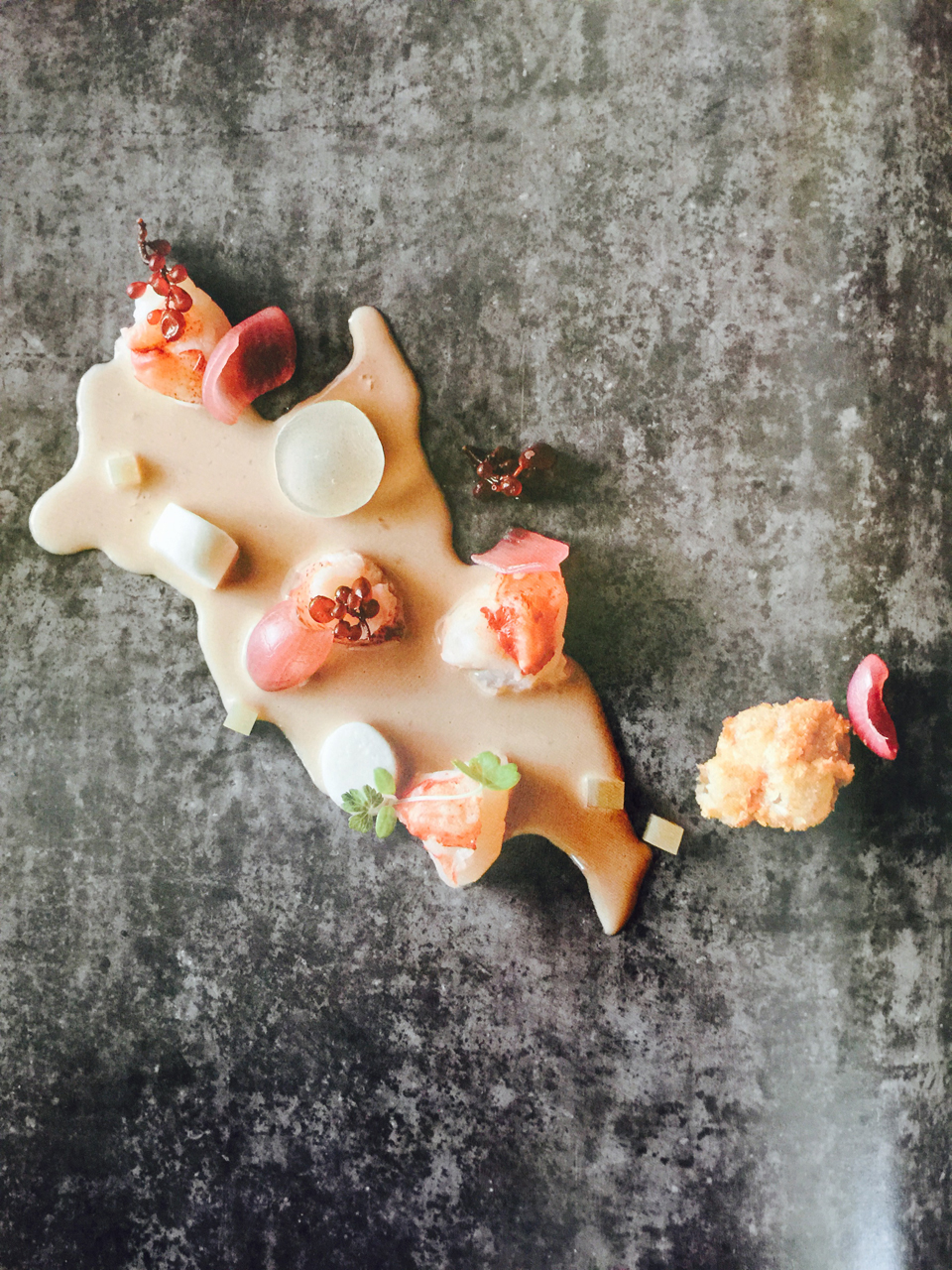Foodie Chap With Chef Dominique Crenn
SAN FRANCISCO (CBS SF) - Chef Dominique Crenn of two Michelin starred "Atelier Crenn" is in a groove, a really good groove.
Liam: "What a year for you Chef!?"
Chef Crenn: "I am just beginning!!"

Her first book has just been released "Atelier Crenn: Metamorphosis of Taste". "It's not a cookbook necessarily but a book that tells the story of Atelier Crenn, it's my philosophy with words and pictures. It's personal" says Crenn. The recipes are thorough and for some may be complicated. "Have fun with it" Chef told me "It's just cooking".
In September Chef opened "Petit Crenn" - an homage to her grandmother and mother and the cuisine of her homeland "Brittany". This tasty spot in Hayes Valley, San Francisco has been an instant hit. The convivial, communal style seating gives all an opportunity to break bread together, with people you know and sometimes with people you do not. The 7 course feast is displayed on a chalk board in the dining room. I personally love Petit Crenn (breakfast, lunch & dinner) and especially like bellying up to the counter that wraps around the open kitchen, watching the "culinary show" as it unfolds before you.
And of course "Atelier Crenn" now in it's 4th year goes from strength to strength: one Michelin star then two and perhaps three around the corner. It is a poetic and stellar dining experience and a meal of memories for everyone who is lucky enough to dine there. Reservations are required.
Enjoy my Foodie Chap chat with a Chef who is both artist and rock star. She will scoff at the rock star bit but she IS!!
"I am a cook and please don't call me a female Chef"!!
Cheers, Liam!
I grew up eating beautiful homards bleus, the bright blue lobsters that live off the coast of Brittany. I love lobster in any form, from steamed to grilled, but I was always especially fond of the lobster bisque that my mother used to make, full of fresh cream from my uncle's cows and tomatoes from our garden. At my age, I finally know enough about cooking and memory to recognize that I could never recreate my mother's lobster bisque, even if she gave me the most detailed recipe (and to be honest, she keeps all her recipes in her head, or perhaps her heart). Instead, I try to capture the feelings of lobster bisque, particularly the sense of indulgence born of slurping a rich soup on a warm summer night. My own version of lobster bisque transfers the tomato from the broth to a delicate veil, which one must penetrate to discover bone marrow custards, which stand in for the rich cream of the original. Each spoonful transforms the diner into a kind of fisherman who plunges in to discover the gifts of the sea.
I grew up eating beautiful homards bleus, the bright blue lobsters that live off the coast of Brittany. I love lobster in any form, from steamed to grilled, but I was always especially fond of the lobster bisque that my mother used to make, full of fresh cream from my uncle's cows and tomatoes from our garden. At my age, I finally know enough about cooking and memory to recognize that I could never recreate my mother's lobster bisque, even if she gave me the most detailed recipe (and to be honest, she keeps all her recipes in her head, or perhaps her heart). Instead, I try to capture the feelings of lobster bisque, particularly the sense of indulgence born of slurping a rich soup on a warm summer night. My own version of lobster bisque transfers the tomato from the broth to a delicate veil, which one must penetrate to discover bone marrow custards, which stand in for the rich cream of the original. Each spoonful transforms the diner into a kind of fisherman who plunges in to discover the gifts of the sea.

Lobster Bisque
Serves 10
Bone Marrow Custards
Ingredients:
1800 grams (4 pounds) bone marrow cut into cylinders
Kosher salt
420 grams (1[3/4] cups) non-fat milk
6 grams (1[1/5 teaspoons) fine sea salt
2 grams ([2/5] teaspoon) champagne vinegar
50 grams kuzu (kudzu) starch
1.2 grams agar agar
Equipment:
Kitchen gloves
Metal skewer
Fine mesh strainer
Acetate sheets
Painter's tape or masking tape
Powerful blender
Rondeau or similar wide-bottomed pot
Pastry bag
Bain-marie or large heat-resistant measuring cup
Acetate sheet
One day before serving:
While wearing kitchen gloves, use a metal skewer to scrape the marrow out of the bones. Discard the bones.
To brine the bone marrow: Soak the bone marrow in a storage container with a lid. Using a 20 to 1 ratio of water to kosher salt, mix enough brine to cover the bone marrow completely. Refrigerate, covered, overnight to draw out the blood.
The next day:
Strain the marrow and discard the brining liquid. In a large pot, render the bone marrow pieces over medium-low heat until they start to brown and liquefy, about 30 minutes.
Push the bone marrow through a fine mesh strainer to remove any remaining sinewy pieces. Let the bone marrow cool, uncovered, at room temperature.
Bring the milk out of the refrigerator to warm up to room temperature.
To prepare the acetate molds: Cut the acetate sheets into 3 20x5-inch rectangles. Roll each rectangle of acetate lengthwise into a 20-inch cylinder and use painter's tape or masking tape to secure the seam. Wrap the bottom of the tube in two layers of plastic wrap.
In a blender, combine the milk, salt, and champagne vinegar and blend on high for 10 seconds. Add the kuzu and blend on high, scraping down the sides if necessary, until the kuzu is incorporated, about 20 seconds. Add the agar agar and blend on high for 10 seconds. Add 170 grams (6 ounces) of rendered bone marrow and blend on high for 20 seconds.
Transfer the milk-kuzu mixture to a rondeau or similar wide-bottomed pot and bring to a simmer over medium-high heat until the milk mixture starts to thicken, about 30 minutes. Stir with a flat wooden spatula, scraping along the bottom of the pan to prevent burning, until the mixture begins to pull away from the sides of the pot, about 10 minutes.
Place a pastry bag in a small bain-marie or large heat-resistant measuring cup and fold the sides over the edges. Pour the mixture into the pastry bag and secure with a tight knot.
Using a towel or kitchen gloves to handle the hot pastry bag, pipe the mixture into the acetate tubes until they are full. Chill the acetate tubes in the refrigerator until set to a firm gel, at least 1 hour.
Line a tray with an acetate sheet. Remove the tape and slice the cylinder into [1/4]-inch discs, reminiscent of bone marrow. Arrange the slices of bone marrow custard in a single layer on the acetate sheet, cover with plastic wrap, and refrigerate until ready to serve.
Poached Lobster and Lobster Bisque Broth
Ingredients:
1 large fennel bulb
1 white onion
1 carrot
1 garlic clove
120 grams ([1/2] cup) white wine
5 sprigs thyme
1 bay leaf
2.5 grams ([1/2] teaspoon) fine fine sea salt, divided
5 whole Maine Lobsters
125 grams ([1/4] pound) unsalted butter
Lobster Stock (see page 000)
1350 grams (5[1/2] cups) non-fat milk
2 grams guar gum
Equipment:
Large heavy-bottomed pan
Medium heavy-bottomed pan
Fine mesh strainer
Powerful blender
Eight hours before serving:
To prepare the lobsters: Plunge a sharp knife directly behind each lobster head. Cut the heads from the bodies. Remove the gills from the bodies and discard. Remove the antennae from the heads and discard. Rinse with cool water.
To poach the lobster in court bouillon (quick vegetable stock): Roughly chop 1 of the fennel bulbs, reserving the fennel fronds. Peel the onion and roughly chop. Roughly chop the carrot, discarding the top. Peel and finely chop the garlic. In a large pot with a fitted lid, combine 500 grams (2 cups) of water with the white wine, fennel, onion, carrot, garlic, thyme, bay leaf, and a pinch of fine sea salt. Bring to a simmer over high heat and simmer, uncovered, for 8 minutes. Place a steaming rack at the bottom of the pot. Place the lobsters head-downward in the pot and steam until the shell turns bright red, 7 to 10 minutes. Depending on the size of your pot, you may need to work in batches and replenish the water as necessary. Reserve the remaining court bouillon refrigerated; court bouillon should be brought to a boil every time it is re-used.
Once the lobsters are cooked, rinse them with cold water. Separate the meat from the shells and the brains from the heads. Reserve the brains to make lobster brain-tomato gel (see page 000) and reserve the meat to cook with sweetbreads immediately before serving (see page 000).
Cut the butter into a large ([1/2]-inch) dice and set out to soften.
Use the lobster shells to prepare lobster stock (see page 000).
Transfer 500 grams of the lobster stock to a powerful blender and freeze or reserve the remaining stock for another use.
While the lobster stock is still hot, add the softened butter to the blender and blend on high until fully incorporated, about 15 seconds. Add the non-fat milk and 2 grams of fine sea salt and blend on high until fully incorporated, about 15 seconds. Turn the blender down to low speed and pour the guar gum directly into the liquid without touching the side of the blender, about 10 seconds.
Season to taste with fine sea salt.
Lobster Brain-Tomato Gel
Ingredients:
1 fennel bulb
1 leek
2 celery stalks
5 grams ([1/2] tablespoon) whole black peppercorns
5 grams fennel seed
1 bay leaf
6 lobster brains (reserved from recipe above)
100 grams (scant [1/2] cup) unsalted butter
250 grams dry vermouth
Tomato consommé (see page 000)
0.75 grams ([1/8] teaspoon) fine sea salt
22.5 grams agar agar
Equipment:
Fine mesh strainer
10x10-inch shallow square container
At least four hours before serving:
Wash and cut 50 grams of fennel, 50 grams of leek, and 50 grams of celery against the grain into [½]-inch pieces.
In a medium bowl, mix together the peppercorns, fennel seed, and bay leaves.
In a medium heavy-bottomed pot, melt the butter on medium-high heat until it just begins to brown, about 90 seconds. Add the lobster brains and pan-roast, turning occasionally, about 5 minutes. Add the fennel, leek, celery, peppercorns, fennel seed, and bay leaf and cook over medium heat for 10 minutes.
Pour the vermouth into the medium pot to deglaze. Simmer over medium heat, scraping along the bottom, until the liquid reduces by half, about 2 minutes.
Add 1500 grams (6[1/3] cups) of water to the medium pot and simmer over medium-low heat until the volume reduces to one sixth, about 2 hours.
Strain the contents of the pot through a fine mesh strainer, discarding the strained solids.
Prepare tomato consommé (see page 000), but do not season with fine sea salt.
In a medium pot, combine 500 grams (1 pint) of tomato consommé and 250 grams (1 cup) of reduced lobster brain broth together with the agar agar and fine sea salt. Bring the mixture to a boil over medium heat and stir for 10 seconds. Remove from heat.
Strain the mixture through a fine mesh strainer into a shallow square container approximately 10x10 inches to yield a [½]-inch depth and discard the solids. Chill the strained mixture, uncovered, in the refrigerator until completely set, about 1 hour.
Without removing the gel from the container, slice into [½]-inch squares. Wrap the container in plastic wrap and refrigerate until ready to serve.
Fried Sweetbreads
Ingredients:
1850 grams (2 quarts) milk
5 veal sweetbreads
Equipment:
Cooking thermometer
Five hours before serving:
In a large pot with a cooking thermometer attached, combine the cold milk and sweetbreads and bring to a temperature of 71[dg]C/160[dg]F. Adjust the heat setting to cook the sweetbreads in the milk at 71[dg]C/160[dg]F for 20 minutes.
Remove the sweetbreads and discard the milk.
To press the sweetbreads: Arrange the sweetbreads in a single layer on a dinner plate and cover with another dinner plate. Place a 1 kilogram (2 pound) weight on top of the upper plate. Refrigerate until firm, about 24 hours.
To trim the sweetbreads: Using your fingers, remove the skin, ducts, and outer membrane from the sweetbreads.
Slice the sweetbreads into nickel-sized slices and keep refrigerated until 1 hour before serving, then let sit at room temperature to temper before frying to order.
Dehydrated Seaweed
Ingredients:
200 grams (7 ounces) "mermaid's hair" seaweed
Equipment:
Dehydrator (optional)
At least three hours before serving:
Cut the seaweed into 4-inch strips.
To dry the seaweed in a dehydrator: Place an acetate sheet in a dehydrator tray. Evenly spread the seaweed across the acetate sheet. Transfer the tray to a dehydrator set to 60[dg]C/140[dg]F until completely dry and crispy, about 3 hours.
To dry the seaweed in an oven: Preheat the oven to 60[dg]C/140[dg]F or the closest temperature available. Place an acetate sheet in a baking sheet. Evenly spread the seaweed across the acetate sheet. Transfer the baking sheet to the oven and turn off the heat. Let the seaweed dry in the closed oven until completely dry and crispy, about 3 hours.
Vegetable Dashi Veil
Ingredients:
25 grams daikon
10 grams fresh peeled ginger
3.5 grams ([1/4] tablespoon) fine sea salt
3.5 grams kombu
5 grams agar agar
10 grams low acyl gellan
Equipment:
Fine mesh strainer
4-inch ring mold
3 13x18-inch (half sheet) pans or cookie sheets
Note: This vegetable dashi recipe is adapted from our regular vegetable dashi recipe (see page 000), to yield an appropriate amount.
Two hours before serving:
To make vegetable dashi: Peel and cut the daikon into [¼]-inch cubes. Julienne the ginger. In a large stockpot, bring 1 liter (4[1/4] cups) of water to a boil. Add the daikon, ginger, and salt. Cover, remove from heat, and let sit for 20 minutes.
Strain the vegetable dashi through a fine mesh strainer and reserve the daikon for another use.
In a medium pot, bring 500 grams of vegetable dashi up to a boil, reserving the remaining vegetable dashi for use in the plankton gel recipe, below. Whisk in the agar agar and low acyl gellan and remove from heat.
Strain the mixture through a fine mesh strainer and discard the solids.
Pour the mixture evenly into 3 18x13-inch (half-sheet) pans. Refrigerate, uncovered, until set to a gel, about 1 hour.
Use a 4-inch ring mold to create circular veils. Refrigerate, covered, on the half sheet trays until ready to plate. (At Atelier Crenn, we transfer all of the veils onto an acetate sheet to save refrigerator space, but doing so is not necessary.)
Plankton Gel
Ingredients:
280 grams vegetable dashi
1.4 grams (1[2/5] teaspoons) xanthan gum
1.4 grams (1[2/5] teaspoons) locust bean gum
0.6 gram low acyl gellan
0.3 gram high acyl gellan
0.3 gram powdered plankton
Equipment:
Blender
Vacuum sealer (optional)
3 centimeter half-sphere molds
One hour before serving:
In a blender, combine the vegetable dashi, xanthan gum, locust bean gum, low acyl gellan, high acyl gellan, and powdered plankton and blend on high to incorporate, about 1 minute.
To cook the gel: Fill a large pot three-quarters full with water and bring to a boil. Transfer the mixture to a vacuum bag, seal and compress at 99%; alternately, transfer the mixture to a resealable plastic freezer bag, squeeze out as much air as possible, and seal the bag. Submerge the bag in the boiling water and cook for 30 minutes.
Open the bag and transfer the contents to 3-centimeter half-sphere molds. Refrigerate, uncovered, until the gel has set, about 1 hour.
Cover with plastic wrap and refrigerate until ready to serve.
Pickled Pearl Onions
Ingredients:
150 grams ([2/3] cup) red wine vinegar
150 grams (4/5 cup) granulated sugar
1.5 grams ([3/10] teaspoon) fine sea salt
20 white pearl onions
At least thirty minutes before serving:
In a small pot, combine 150 grams ([2/3] cup) of water with the red wine vinegar, sugar, and fine sea salt and bring to a simmer over medium heat.
Meanwhile, prepare the pearl onions: Cut off the base of each onion and quarter lengthwise. Peel off and discard the outer petals.
Transfer the onions to a medium bowl and pour the pickling liquid on top, shifting the onions to submerge. Allow to cool, uncovered, at room temperature, then cover and refrigerate until ready to serve.
To Serve:
Ingredients:
Fennel fronds (reserved from lobster bisque recipe, above)
10 stems Japanese sea grapes
100 grams egg whites
20 grams (2[1/2] tablespoons) corn starch
1.5 grams ([1/4] teaspoon) fine sea salt
50 grams panko
50 grams ([1/3] cup) rice flour
Equipment:
Immersion circulator or stockpot with cooking thermometer
To warm each serving sous vide: For each diner, fill 1 vacuum bag with 25 grams of lobster bisque, 3 chunks of lobster meat (reserved from lobster bisque recipe, above), 1 plankton gel, 1 lobster brain, 2 bone marrow dumplings. Seal the bags and cook together sous vide in an immersion circulator set to 72[dg]C/160[dg]F for 15 minutes. Open each bag and transfer the contents to a shallow bowl.
To warm the bisque on the stove: In a large pot, combine 150 grams of broth, 18 chunks of lobster meat (reserved from lobster bisque recipe, above), 6 plankton gels, 6 lobster brain gels, 12 bone marrow dumplings, and 6 sea grape stems. Warm over medium heat to 72[dg]C/160[dg]F, then divide into shallow bowls, with each serving containing 25 grams of lobster bisque, 3 chunks of lobster meat (reserved from lobster bisque recipe, above), 1 plankton gel, 1 lobster brain gel, 2 bone marrow dumplings, and 1 stem of grape seaweed.
While the bisque is warming:
Make the slurry: Separate the eggs. In a large bowl, whisk together the egg whites, corn starch, and fine sea salt.
Make the breading: In a spice grinder, grind the panko until it is slightly less coarse, about 30 seconds. In a large bowl, mix together the ground panko and rice flour.
Batter the sweetbreads: Coat each sweetbread in the slurry and immediately dip in the panko breading, making sure that the entire surface is encrusted with the breading.
Fill a small pot three-quarters full of vegetable oil and attach a cooking thermometer. Bring the temperature of the vegetable oil to 175[dg]C/350[dg]F. Add the battered sweetbreads and fry for 2 minutes, then remove with a slotted spoon and let rest on a paper towel. Season the sweetbreads to taste with fine sea salt.
Place 1 slice of fried sweetbread in each bowl of lobster bisque.
Float 1 vegetable dashi veil on top of each bowl.
Place 1 micro fennel frond on top of each veil.
Top each bowl with dehydrated seaweed.
Decorate each bowl with a few petals of pickled pearl onion and 1 sea grape stem.
For more information, visit:




